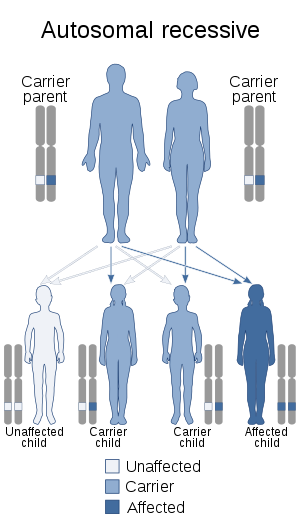Andermann syndrome
Andermann syndrome, also known as agenesis of corpus callosum with neuronopathy (ACCPN) and Charlevoix disease, among other names,[1] is a very rare neurodegenerative genetic disorder that damages the nerves used to control muscles and related to sensation and is often associated with agenesis of the corpus collosum.[1][2][3][4][5]
| Andermann syndrome | |
|---|---|
| Other names | KCC3 axonopathy, Agenesis of corpus callosum with neuronopathy (ACCPN), Charlevoix disease |
 | |
| This condition is inherited in an autosomal recessive manner | |
| Specialty | Medical genetics, neurology |
It was first described by Eva Andermann et al. in 1972.[3][6][7]
Symptoms
Symptoms begin in infancy and include:[2][4]
- hypotonia
- areflexia
- amyotrophy
- variable degrees of dysgenesis of the corpus callosum
- mild to severe intellectual and developmental delay
- psychiatric problems including paranoid delusions, depression, hallucinations and autistic-like behavior
Genetics
The inheritance pattern is autosomal recessive.[4] Several genes have been associated with the disorder, including SLC12A6.[6]
Neuropathology
Autopsy examination of 8 cases[8] has shown both developmental and degenerative neuropathologic features in this disease, consistent with clinical duality as both a neurodevelopmental and neurodegenerative disorder.
In the central nervous system, accompanying the hypotonia at birth is hypoplasia of the corticospinal tracts. Another developmental feature is seen in the corpus callosum, which varies from absent to hypoplastic. The anterior commissure is almost always absent, but occasionally hypoplastic. A bundle of Probst can be found running antero-posterior rather than crossing the midline. The axonal damage due to the channel deficiency can cause a reactive axonal overgrowth leading to small tumor-like growths, or tumorlets, called axonomas, or balls of aberrant axons. Damaged axons can also show a sign of inhibition of axonal transport, forming axonal spheroids. These spheroids can be throughout the cerebral hemispheres, explaining the psychotic symptoms by disconnection of the brain from itself by axonal functional disruption.
In the Peripheral nervous system, the disease is more severe. While most nervous system diseases affect either CNS or PNS, this disease affects both, but it is the changes in the peripheral nervous system that lead to death. This occurs by axonal disease paralyzing the skeletal muscles, including the respiratory muscles as a result of axonal damage in peripheral nerves. Changes in the axons are more severe in the PNS than CNS and under the electron microscope, some axons look necrotic, by virtue of containing mitochondrial flocculent densities and other irreversible changes.[8] The lack of innervation of the body musculature during development gives rise to small body weights, often below 40 kilograms, remarkable in view of the preserved brain weights.[8]
Diagnosis
Typical diagnostic workup includes[9]
- clinical features
- electrophysiologic testing
- molecular genetic testing (SLC12A6)
- magnetic resonance imaging (MRI) of the brain (revealing in 60% of the patients callosal agenesis and in 10% partial callosal agenesis)
Treatment
There is currently no cure, but some symptoms may be treated such as neuroleptics for the psychiatric problems.[5]
Prognosis
The prognosis is poor. Patients are usually wheelchair bound by their 20s and die by their 30s.[4][5]
Prevalence
The prevalence rate has been estimated to be less than 1/1,000,000 worldwide.[4] However, it is much more common in the French-Canadian population of the Saguenay and Lac-St-Jean regions of Quebec, Canada, where it has a frequency of about 1 in 2100 in live births, and a carrier rate of 1 in 23.[5]
References
- "Andermann syndrome". Genetics Home Reference. NIH. Retrieved 19 January 2017.
- "Andermann syndrome | Genetic and Rare Diseases Information Center (GARD) – an NCATS Program". rarediseases.info.nih.gov. Retrieved 2017-01-19.
- "AGENESIS OF THE CORPUS CALLOSUM WITH PERIPHERAL NEUROPATHY; ACCPN". www.omim.org. Retrieved 2017-01-19.
- RESERVED, INSERM US14 -- ALL RIGHTS. "Orphanet: Corpus callosum agenesis neuronopathy syndrome". www.orpha.net. Retrieved 2017-01-19.
- Dupré, Nicolas; Howard, Heidi C.; Rouleau, Guy A. (1993-01-01). "Hereditary Motor and Sensory Neuropathy with Agenesis of the Corpus Callosum". In Pagon, Roberta A.; Adam, Margaret P.; Ardinger, Holly H.; Wallace, Stephanie E.; Amemiya, Anne; Bean, Lora JH; Bird, Thomas D.; Ledbetter, Nikki; Mefford, Heather C. (eds.). GeneReviews. Seattle (WA): University of Washington, Seattle. PMID 20301546.
- Uyanik, G.; Elcioglu, N.; Penzien, J.; Gross, C.; Yilmaz, Y.; Olmez, A.; Demir, E.; Wahl, D.; Scheglmann, K. (2006-04-11). "Novel truncating and missense mutations of the KCC3 gene associated with Andermann syndrome". Neurology. 66 (7): 1044–1048. doi:10.1212/01.wnl.0000204181.31175.8b. ISSN 1526-632X. PMID 16606917.
- Andermann, Eva (1972). et al. "Familial agenesis of the corpus callosum with anterior horn cell disease: a syndrome of mental retardation, areflexia, and paraplegia". Transactions of the American Neurological Association. 97: 242–244.
- Auer RN, Laganière JL, Robitaille YO, Richardson J, Dion PA, Rouleau GA, Shekarabi M (2016). "KCC3 axonopathy: neuropathological features in the central and peripheral nervous system". Modern Pathology. 29 (9): 962–976. doi:10.1038/modpathol.2016.90. PMID 27230413.
- Dupré, Nicolas (12 June 2014). "Hereditary Motor and Sensory Neuropathy with Agenesis of the Corpus Callosum". Retrieved 18 April 2020.
External links
| Classification | |
|---|---|
| External resources |
- Andermann syndrome at OMIM
- Andermann syndrome at Orpha.net
- Andermann syndrome at GARD